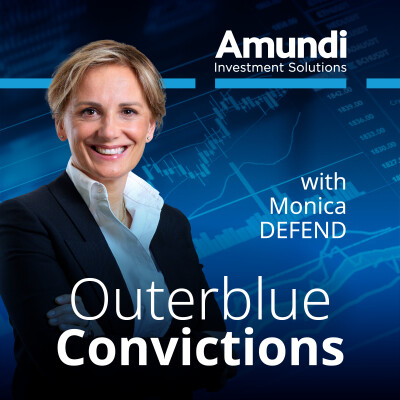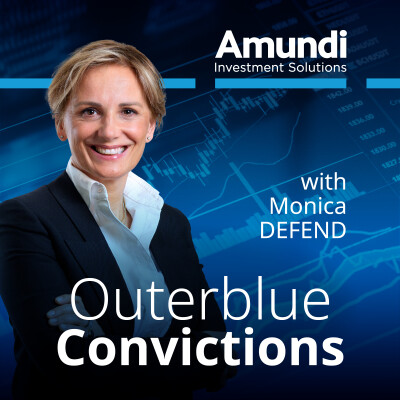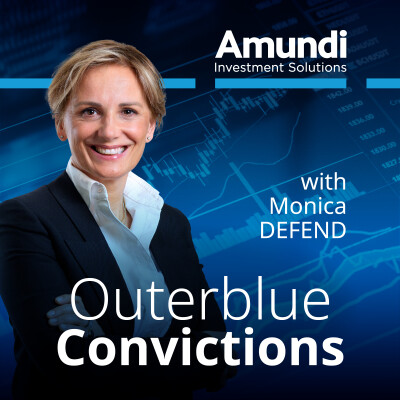- Disclaimer
This podcast is only for the attention of professional investors in the financial industry. Outerblue by Amundi. Welcome to Outerblue Convictions, Market Analysis and Asset Allocation Views.
- Swaha Pattanaik
Hello and welcome to this special edition of our Convictions podcast, where we are going to take a bit of a longer range view than usual and discuss the 2026 outlook for the global economy and financial markets. I'm Swaha Pattanaik, the Head of Publishing and Digital Strategy. Joining me today is our usual guest star, Monica Defend, the Head of the Amundi Investment Institute. Hello, Monica.
- Monica Defend
Hello, Swaha. Hello, everybody.
- Swaha Pattanaik
Monica, it seems not that long ago that we were here talking about the 2025 outlook. A lot's happened in the past year in terms of market moves, geopolitical events, economic developments. It can't have been an easy job to project what's going to happen 12 months from here, given all the uncertainty and flux that the global economy is going through. So let me put you on the spot and ask you to give us the summary of your thinking, which I think is encapsulated in the title of the Outlook. So tell us the title of the Outlook and the thinking behind it.
- Monica Defend
Yes, thank you. Well, the title is "Keep It Turning", just to emphasize this idea of things that keep on moving. But in a nutshell, what we are seeing is a world that is in transformation. We do see a moderation in growth, but not a downturn amid a controlled disorder, just to emphasize all the changes that are in place and will stay with during 2026. I'm talking about a transition in a cycle and markets that will be driven by capital expenditure in intelligence, artificial intelligence, defense, and very important industrial policies that globally are reoriented towards a reallocation of capital, reshaping of trade, raising costs, and moderating activity, though without a collapsing globalization. We do have a 60% probability of the base scenario, which honestly is not that high, but emphasizes and encapsulates all the risks that we see in the coming year.
- Swaha Pattanaik
Thank you, Monica. So you mentioned the incredible investment we've been seeing in artificial intelligence and related sort of adjacent sectors. So it's been a really positive force already when it comes to buoying economic activity. It's however also one of the risks that your outlook identifies because of the levels to which valuations have risen in, say, US blue-chip stock indices. How much do you think AI will either help or hinder growth in markets next year?
- Monica Defend
Well, AI will continue to help, but definitely the economic cycle, but concentration and valuation risk eventually call for a moderate risk exposure. So we are risk on, but on a soft tone. We are looking for global and diversified search for winners in this transformative year. So the $1 million question is, are we in a bubble? We don't think we are in a bubble yet, but we needed to be very selective in the positioning we wanted to stand. Either in the equity space, for example, we maintain exposure to AI with defensive and cyclical themes, financials, industrials that might benefit, should benefit, from higher investment or defense names that are tied to security spending. It is the case, for example, with some small cap in the euro area. But also the green transition stocks that are linked to electrification and grids are something we are looking at as an opportunity for investment.
- Swaha Pattanaik
Thanks, Monica. So the other source of support for markets this year has been sort of the policy backdrop, if you like, both fiscal, monetary policy. What sort of central bank support specifically do you expect to see next year in the major economies and what sort of growth outcomes are you expecting in the major economies?
- Monica Defend
Well, when it goes to monetary policy, it remains central and it will remain, in particular, for the ECB, the Fed and the Bank of England in an accommodative stance, meaning they will cut rates. It is more debatable for the sequencing, the timing of the cuts. Let's see what the Fed will deliver. For now, we stay with a 25 basis point cut in December. This is not a deal done. We do expect more to come in 2026. But the key message here is for the US monetary policy, they will have a gradual approach to tackle the weaknesses we see and they see in the labour market. ECB, the ECB, for us, it's unnecessarily hawkish. Let's see what they will deliver in terms of projections in December. But we will likely see two cuts of 50 basis points in 2026. Bank of Japan is the only exception. They will hike rates. We have plus 1% between now and the first quarter of the next year. While the Bank of England probably is the easier one, where we expect them to cut with a terminal rate around 350.
- Swaha Pattanaik
Thank you, Monica. One of the issues around the central banking debate has been some of the politicization, perhaps especially in the US. Now, I mean, in theory, rate cuts are good for fixed income. It depends why central banks are cutting, of course. So I'm just wondering what your views are on fixed income and whether you think these risks, both on the fiscal front in the US or central bank independence issues, are they sort of priced in enough?
- Monica Defend
I don't think honestly that the Fed independence is rightly priced by the market, as well as the fiscal risk in the United States. When it goes to the Fed independence, our worry is related to the potential for inflation to get higher should the Fed be forced to cut more than fundamentals will need. And we have a 3.25% terminal rate for 2026. This aims for a yield curve that will be steeper, probably more in the second half of the year, but for breakevens to be a nice place to sit on along the year. When it goes to the euro area, definitely it is core to our allocation, given also the potential weakness on the US dollar. So core and the periphery, think about Spain or Italy, are offering good returns, risk-adjusted returns, as well as the IG sector.
- Swaha Pattanaik
So that's the investment grade credit, so higher rated.
- Monica Defend
Yes, exactly. Because eventually we think that the corporate sector is in good shape and sitting on solid fundamentals. On high yield, probably we need to stay more selective and on the short end of the curve.
- Swaha Pattanaik
Perfect. Thanks, Monica. And the other place that a lot of the concerns about the outlook of the US economy or some of the risks have been showing up is the dollar, where some usual relationships where the dollar has in the past tended to move inversely to equity markets or higher risk assets has sort of broken down. What are you expecting on the dollar in some of these relationships next year?
- Monica Defend
Yes, the US dollar, while some clear trends are visible when compared to the yen or the sterling. It is less the case with the euro area. What is happening is that the US growth continues to surprise on the upside. So macro fundamentals no longer appear to us as a clear drag to the US dollar. But we still see scope for a weakening in a non-linear fashion because of the US assets being less central in the allocation of global portfolios. But if you wanted to have a number, we do see the euro/dollar around 119 by the end of the year.
- Swaha Pattanaik
Okay. I mean, Europe was one of the ideas that has been strongly pushed by you, your teams this year as people were looking for alternatives to a very highly concentrated US market rally. Europe is also on the cards next year. Would you talk us through some of the ideas for diversifying away from this concentrated risk or just diversifying portfolios in general that are included in this year's outlook looking ahead?
- Monica Defend
Well, there is a diversification theme that I think will be really prominent this year, starting from the core allocation, definitely the emerging market that should benefit from external conditions such as the Fed cutting rates, a weaker US dollar. But there are some interesting domestic stories. I'm thinking about notably China and India, but overall, the emerging markets, when you split them into regions, on the debt side, for example, local currency, this is something that definitely will help diversifying the portfolios. Then, given that we expect some risks, gold stays as a structural hedge and will remain so. We have a target of 4,200 for next year, but longer term, we see further upside on this commodity because of structural trends in place. Demand is changing, demand from central banks, but also for retail investors that is flashing in some volatility in the, you know, day by day trading. And then private markets. Infrastructure offers inflation protection, great for diversification and to some extent also private debt. Energy security, reshoring and AI, as well as robust demand for private capital, in particular in Europe, will also be positive for this positioning. Obviously, you will need discipline in the selection, rigorous underwriting and strong covenants.
- Swaha Pattanaik
Absolutely, Monica. So, I mean, a mix of optimism, but making sure that we're keeping a clear eye on the risks underlying all of this, given the flux. It seems to be the message.
- Monica Defend
Thank you for framing it so nicely.
- Swaha Pattanaik
Thank you, Monica, for joining us and for covering so much ground. I think a whole year in about 10 minutes is impressive. Thanks for coming on the show. And thank you for listening to this podcast. If you'd like to learn more about some of the themes and ideas that we've been discussing, check out the full outlook on the Amundi Research Center. We will catch you next time.
- Disclaimer
This podcast is only for the attention of professional investors. As defined in Directive 2014-65-EU, dated 15 May 2014, as amended from time to time on markets and financial instruments, called MIFID II. Views are those of the author and not necessarily Amundi Asset Management SAS. They are subject to change and should not be relied upon as investment advice, as a security recommendation, or as an indication of trading for any Amundi products or any other security, fund units, or services. Past performance is not a guarantee or indicative of future results.






